33 Free PESTLE Analysis Templates (Excel, Word, PPT, PDF)
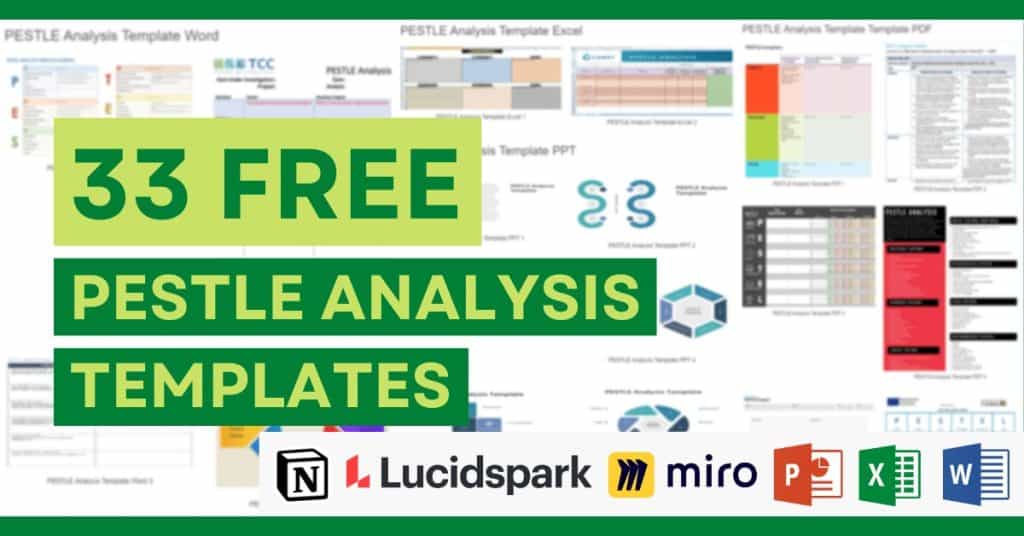
A PESTLE analysis template is a tool that enables you to understand how some elements might affect your business. PESTLE stands for Political, Economic, Social, Technological, Legal, and Environmental factors. They are external factors that represent threats and opportunities to your organization.
PESTLE Analysis VS SWOT Analysis
PESTLE analysis focuses on factors outside a business’s control and can affect risks and opportunities. On the other hand, SWOT analysis focuses on a business’s internal factors that are controlled by the business but can affect its weaknesses and strengths.
When should you do a PESTLE Analysis?
Organizations use PESTLE analysis to track, discover, organize, and evaluate the macroeconomic factors underlying their business outcomes. This analysis is useful as it helps inform budget allocation, strategic planning, and market research.
You should do a PESTLE analysis when you want to make a strategic assessment of where you stand and what you may go through in the future. This is useful when planning organizational change, marketing, product and business development, and research.
The 6 Factors of a PESTLE Analysis
The six factors of a PESTLE analysis are explained below:
- Political: Organizations are affected by politically motivated or political factors. For example, trade restrictions and trade policy, government policy, copyright laws, or environmental laws might affect your company. When conducting a PESTLE analysis, you must ask: What political elements could disrupt or benefit our company?
- Economic: Economic factors can be detrimental or beneficial for your business. For example, seasonal changes, industry growth, exchange rates, growth rates, unemployment rates, interest rates, and taxation can potentially impact businesses. When measuring the economic factor, you must ask: What factors might affect the company’s revenue?
- Social: Social trends might affect your customers. For example, beliefs about money, leisure, lifestyles, and immigration can affect your business. When evaluating the social factor, you must ask: How do the customers’ values influence their buying decisions?
- Technological: Technology can impact your organization’s capability to market services and products. For example, legislation around technology, communications and technology infrastructure, and research and development impact most organizations and businesses. When assessing the technological aspect, ask: How technology might affect our success and growth?
- Legal: Legal factors can have an impact on the operations of your organization. For instance, labor laws and consumer laws might affect your organization. When assessing the legal factor, you must ask: How might legal frameworks jeopardize the ability of your organization to operate?
- Environmental: Some industries, such as farming, tourism, and agriculture, are sensitive to changes in the environment. For example, weather, climate change, and geographic location might affect a company’s business decisions. When evaluating the environmental factor, you should ask: How might the environmental changes hinder or help our company’s operational ability?
7 PESTLE Analysis Templates in Word format
- PESTLE Analysis Template Word 1
- PESTLE Analysis Template Word 2
- PESTLE Analysis Template Word 3
- PESTLE Analysis Template Word 4
- PESTLE Analysis Template Word 5
- PESTLE Analysis Template Word 6
- PESTLE Analysis Template Word 7
How do you run a PESTLE Analysis?
- Brainstorm the various PESTLE factors: Consider the six PESTLE factors that might affect your business: political, social, economic, legal, technological, and environmental. Hold a brainstorming session or invite your team members to brainstorm and come up with ideas. The goal should be to identify specific ways in which these factors can affect your business and the way you might deal with these factors.
- Rank these factors: Rank the factors based on the level of impact they might have on your organization. Discuss discrepancies in ratings if there are any significant ones. Allow space and time for the people to make up their minds. Adjust the rankings according to the input of your team members.
- Share your analysis: After the analysis is complete, share the completed analysis with relevant stakeholders. Keep the stakeholders informed about what you decide to do with the external factors that can affect your business.
- Repeat: Repeat the PESTLE analysis to keep your processes and strategies up to date. This will enable you to stay informed and knowledgeable about the important factors you need when strategizing the business.
PESTLE Analysis Template Excel
4 PESTLE Analysis Templates in Powerpoint PPT format
- PESTLE Analysis Template PPT 1
- PESTLE Analysis Template PPT 2
- PESTLE Analysis Template PPT 3
- PESTLE Analysis Template PPT 4
6 PESTLE Analysis Templates in PDF format
- PESTLE Analysis Template PDF 1
- PESTLE Analysis Template PDF 2
- PESTLE Analysis Template PDF 3
- PESTLE Analysis Template PDF 4
- PESTLE Analysis Template PDF 5
- PESTLE Analysis Template PDF 6
PESTLE Analysis Template Online Tools
Miro
Use this Miro template to identify the factors that may affect your business.
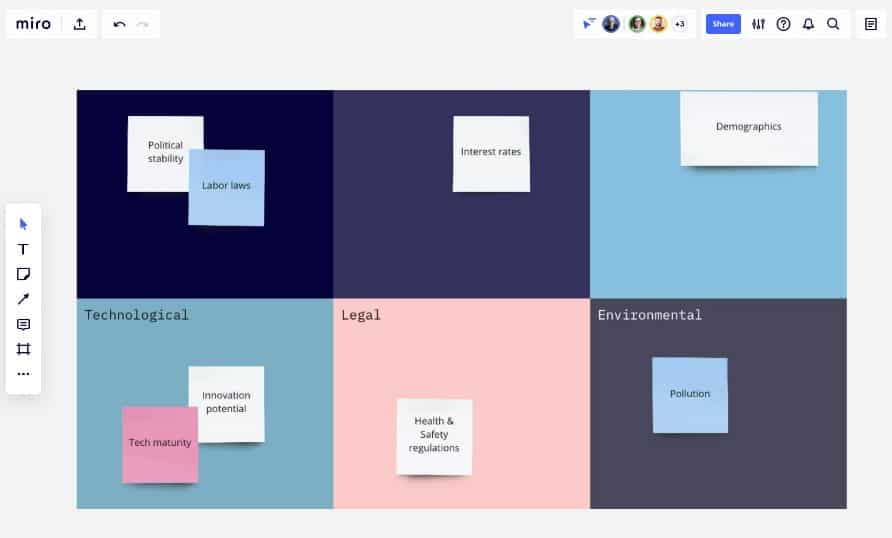
Lucidspark
The Lucidspark PESTLE analysis template enables you to identify and monitor external factors that might impact your business.

ClickUp
Use the ClickUp PESTLE analysis template to prevent risks, prepare for losses, and understand the capabilities of your business. Equip your organization with comprehensive strategy and planning using this template.
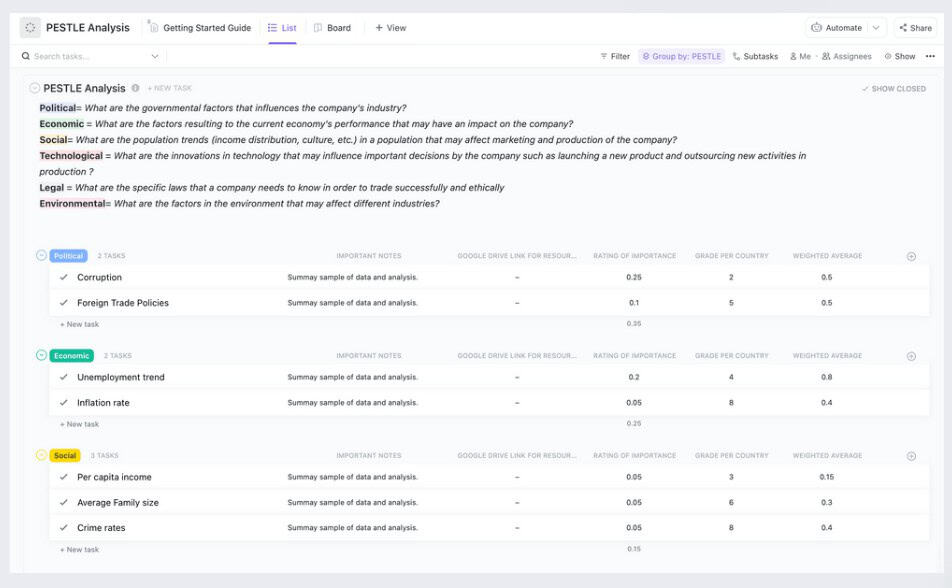
Creately
Use the Creately online template to collaborate with your team members and export the results of the PESTLE analysis to multiple formats.
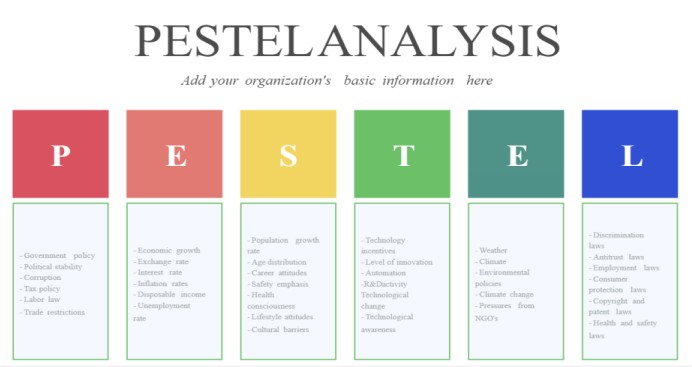
Notion
Use the Notion PESTLE analysis template to assign properties, add attachments, and write notes.
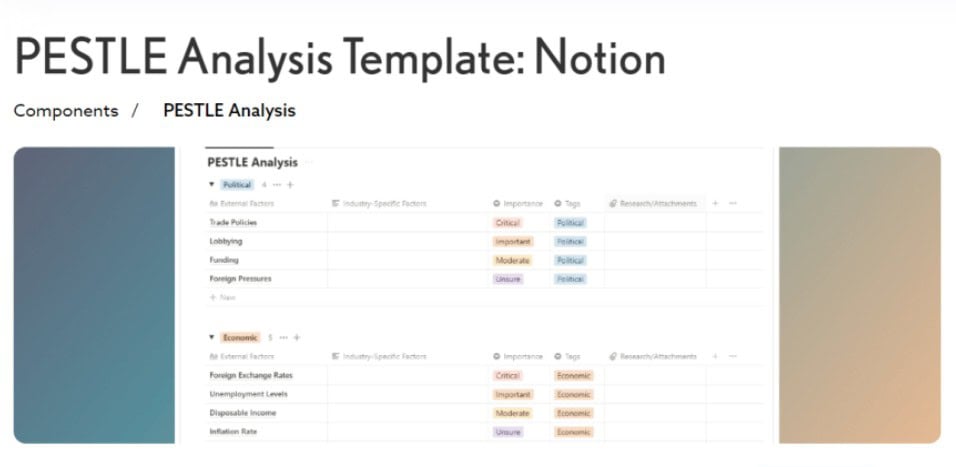
PESTLE Analysis Best Practices
Some best practices for conducting a PESTLE analysis are:
- Collaborate to identify more risks.
- Use resources and expertise within your organization.
- You can use other techniques of PESTLE analysis, such as Porter’s Five Forces, SWOT analysis, scenario planning, or competitor analysis, along with PESTLE analysis.
- Use PESTLE analysis to monitor changes in the business environment.
- Avoid obtaining high amounts of information without understanding and analyzing the findings appropriately.
PESTLE Analysis FAQs
How does PESTLE analysis help identify risks?
PESTLE analysis can be used to identify external risks in risk management plans. It identifies risks under the headings of Political, Social, economic, Legal, Technological, and Environmental.
How often should PESTLE analysis be done?
PESTLE analysis should be done every six months to identify macro-environmental changes.
Is pestle internal or external?
PESTLE examines the external environment of a company.
Is PESTLE analysis cost-effective?
PESTLE analysis is cost-effective and provides a deep understanding of the alertness of threats and business and a way to exploit opportunities.

